Ashfall advisory canceled but scientists say more explosive Kilauea eruptions possible at any time


U.S. GEOLOGICAL SURVEY / HVO
This image was captured at the Kilauea Volcano summit by the Hawaiian Volcanoes Observatory observation tower webcam at 5:44 a.m. today, after an explosive eruption.

U.S. GEOLOGICAL SURVEY / HVO
This image was captured at 6 a.m. this morning at Halemaumau Crater.
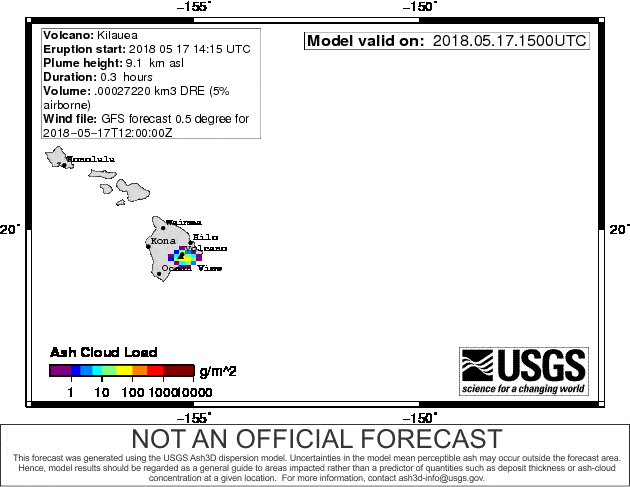
U.S. GEOLOGICAL SURVEY
Scientists at the USGS posted a computer simulation that shows how far the volcanic ash from today’s explosive eruption might travel and how much might fall to the ground.

CINDY ELLEN RUSSELL / CRUSSELL@STARADVERTISER.COM
This aerial view of the Kilauea East Rift Zone from this morning shows the eruption sites and the now-closed Puna Geothermal Venture plant.

COURTESY USGS
A rock hurled from the Halemaumau Crater during an explosive event Tuesday evening was about 24 inches wide before it hit the ground and broke apart, geologists say. The location is a few hundred yards south of the crater at the Halemaumau parking lot, which was covered in about a half-inch of ash.
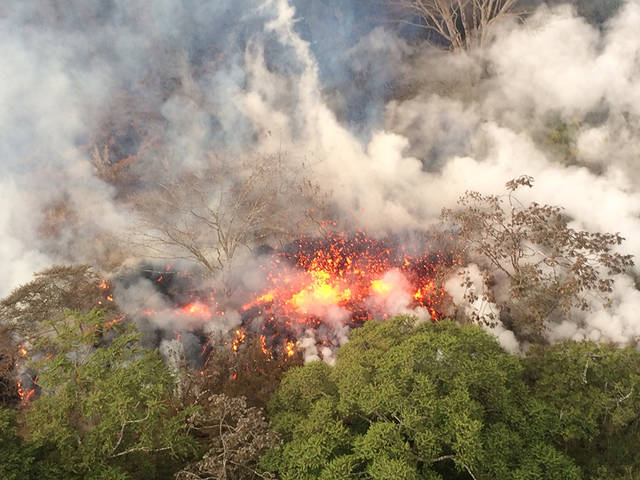
COURTESY USGS
Lava spattering area from an area between fissures 16 and 20 was observed at 8:20 a.m. today.

CINDY ELLEN RUSSELL / CRUSSELL@STARADVERTISER.COM
A plume of ash was seen Tuesday above Halemaumau crater on Hawaii island.
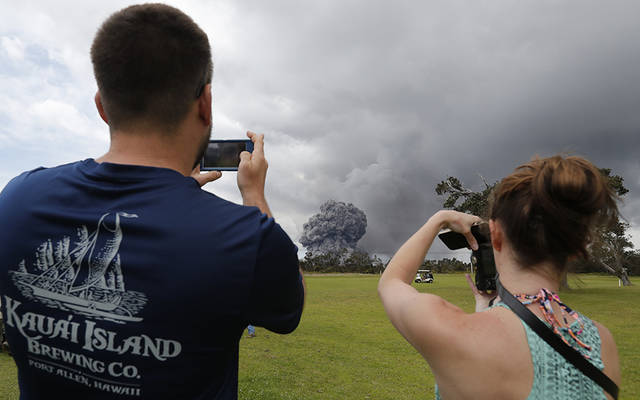
CINDY ELLEN RUSSELL / CRUSSELL@STARADVERTISER.COM
Spectators at the Volcano Golf and Country Club photograph the start of an ash plume billowing out of the Halemaumau crater Tuesday. The forboding plumes develop when rocks drop into lava and explode from intense heat.
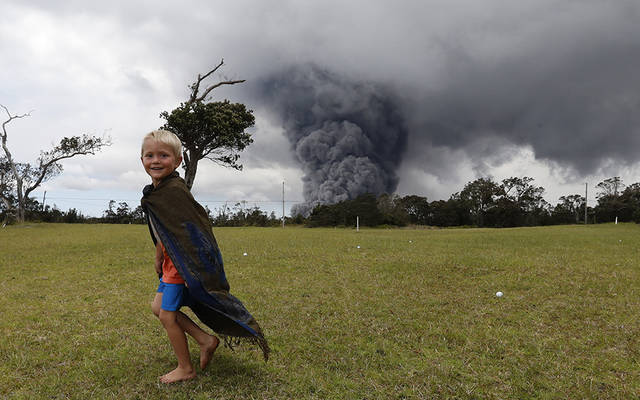
CINDY ELLEN RUSSELL / CRUSSELL@STARADVERTISER.COM
Roland Ellithorpe, 4, runs as an ash plume billows out of Halemaumau crater Tuesday. The plumes, located within the Kilauea caldera, occur when rocks drop into lava and explode from intense heat.
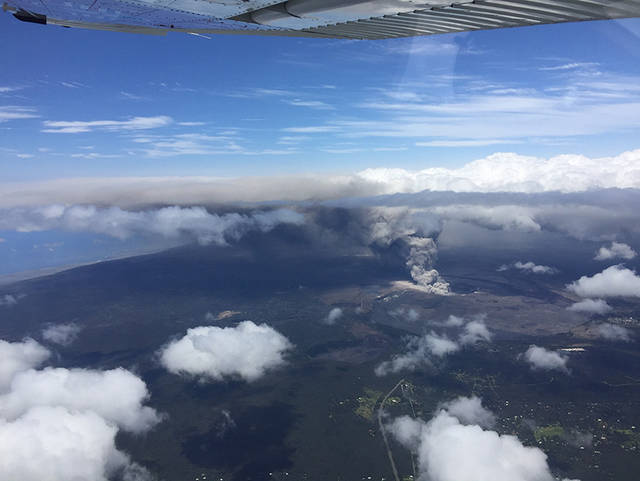
COURTESY USGS
Civil Air Patrol flight at 11:43 a.m. reported ash plume tops at 9,500 feet elevation with the dispersed plume up to 11,000 feet, according to the U.S. Geological Survey. Ashfall from the plume is falling on Hawaii island communities downwind.











Update: 11:45 a.m.
The National Weather Service has canceled an ashfall advisory for the Big Island and surrounding waters, but forecasters warn that addition outbursts of ash from Kilauea are still possible today.
The advisory, which had been posted until 6 p.m. today, was canceled before 11:30 a.m. and replaced by a “special weather statement.”
”Occasional small bursts of volcanic ash may emanate from Halemaumau Crater. These bursts may be brief and could occur at multiple times. Low level winds would tend to push any ash clouds toward west and west-southwest. Most ash fallout would remain mainly over rural areas and Highway 11 to the southwest of the town of Volcano,” the weather statement says.
The ashfall advisory came after a “brief, sudden explosive eruption” at about 4:15 a.m. that sent an ash cloud to nearly 30,000 feet, according to the Hawaiian Volcano Observatory. HVO scientists warn that additional Kilauea summit explosive eruptions of ash and smoke are possible at any time with little warning.
For volcano-related health and safety tips, go to https://vog.ivhhn.org Opens in a new tab
Don't miss out on what's happening!
Stay in touch with breaking news, as it happens, conveniently in your email inbox. It's FREE!
11:15 a.m.
U.S. Environmental Protection Agency officials said they have deployed emergency responders and air monitoring equipment as part of the Federal Emergency Management Agency’s response to the Kilauea eruption.
“EPA remains on the ground assisting Hawaii and our federal partners in monitoring air quality and ensuring the public is informed of all potential health risks from the Kilauea volcano eruption,” said EPA Administrator Scott Pruitt.
The EPA is providing experts to analyze public health threats from gas emissions and for data management support, officials said in a news release this morning. EPA said it has deployed four staff-members and will mobilize more equipment and personnel to support 12 monitoring stations for sulfur dioxide, hydrogen sulfide and particulates.
10:30 a.m.
Free dust masks are being distributed by Hawaii County Civil Defense to help residents in affected areas protect themselves from breathing volcanic ash.
The masks will be distributed at the following locations today from 1 p.m. to 7 p.m.:
>> Cooper Center in Volcano
>> Pahala Community Center
>> Naalehi Community Center
>> Shipman Park Pavilion in Keeau
8:13 a.m.
The ashfall advisory for Hawaii island has been extended through 6 p.m. today.
“Volcanic ash is expected to reach immediate vicinity of the Kilauea Volcano summit (Halemaumau Crater), including Volcano and Glenwood,” the National Weather Service said in a bulletin. “If additional large explosions occur, winds aloft could push the resulting ash to communities of lower Puna such as Pahoa and Kapoho, south to the shoreline.”
Volcanic ash is als0 expected to affect waters off-shore of the Big Island, especially downwind of Kilauea volcano. “Ash accumulation of less than one quarter inch is possible on vessels in the advisory area. Mariners should avoid this area until the ashfall subsides,” the advisory said.
>> LIVE: Webcam images from Halemaumau at Kilauea
>> Lava flow pauses, ash continues to billow from Halemaumau Crater
>> Kilauea summit ash eruption calms down; work to cap geothermal wells begins
>> Video: Big Island evacuee talks about staying at a Red Cross shelter
>> Amount of ash in plume above Kilauea decreases
>> Displaced residents at Red Cross shelter make do in tents
>> As lava destroys Hawaii homes, owners ask, Am I covered?
>> AP Video: Planes warned about Hawaii volcanic ash
>> USGS Video: Kilauea Volcano Update, May 15
>> Photos: Satellite before-and-after images show Kilauea’s devastation
>> Photos: Ash plume rises from Halemaumau
COMPLETE KILAUEA COVERAGE:
Star-Advertiser volcano coverage
Kilauea Volcano YouTube playlist
8:10 a.m.
HILO >> A U.S. Geological Survey geologist described the pre-dawn explosive eruption at the summit of Kilauea as “short-lived” and not having a “widespread impact.”
Scientist Michelle Coombs said at a morning news conference at Hawaii County Civil Defense headquarters in Hilo that the event, which sent a cloud of ash and smoke up to 30,000 feet high, was “consistent with what we were thinking might happen.” She said the ashfall was “localized” around the summit.
She said it was a “real dynamic situation up there” on the summit, and that similar explosive events are still possible.
Coombs called the 4:17 a.m. eruption as the “the biggest so far” at the summit and that it may have relieved pressure temporarily in the caldera at Halemaumau Crater.
Although she could not say with certainty, Coombs said that the event appeared consistent with the dropping lava lake hitting groundwater, as geologists have been expecting.
Wide angle @USGSVolcanoes camera shows incandescence in Halema'uma'u prior to this morning's eruption. Timelapse starts late yesterday afternoon pic.twitter.com/5tDcVkiQIg
— Ian Nesbitt (@paleosurface) May 17, 2018
7:25 a.m.
Due to elevated sulfur dioxide levels, Pahoa High & Intermediate School, Pahoa Elementary, Keonepoko Elementary, Hawaii Academy of Arts and Science, Volcano School of Arts and Science, and Na Wai Ola charter school in Mountain View are closed today. Kindergarten to 4th-grade classes at Ke Kula ʻO Nawahiokalaniʻopuʻu iki was also canceled today due to elevated sulfur dioxide levels.
A spokeswoman for the state Department of Health said elevated sulfur dioxide (SO2) levels were detected at the Pahoa fire station at 6:45 a.m. today.
The Department of Health considers a “Red” hazard level to be 1 part per million, and the higher reading prompted the school closures.
A police spokesman reported elevated sulfur dioxide level on Highway 130 and Highway 132, which is adjacent to the sire of Pahoa High & Intermediate School.
7 a.m.
Continuous ash emissions from Halemaumau crater are reaching as high as 12,000 feet. The earlier explosive eruption produced an ash cloud that reaches as high as 30,000 feet and is drifting to the northeast.
Staffs for the Hawaiian Volcano Observatory and Hawaii Volcanoes National Park had previously evacuated Kilauea summit.
6:20 a.m.
HILO >> Scientists reported an “explosive eruption” at the summit of Kilauea volcano shortly before 4:20 a.m. today that ejected a large plume of ash in the air, and authorities urged residents in the path of the ash to shelter in place.
The Hawaiian Volcano Observatory reports that that the explosive eruption at Kilauea summit occurred at 4:17 a.m. Agency officials said the wind may carry the resulting ash plume north toward Kau, Volcano, Mountain View, Kea’au and as far as Hilo.
Hawaii County Civil Defense issued the alert at 5:26 a.m., and warned that “the resulting ash plume will cover the surrounding area.”
Linda Ugalde, a 20-year resident of Volcano, said she heard and felt nothing, but stepped outside of her home at the Volcano Golf Course subdivision about 10 minutes after the alert to find a film of dark gray ash coating the railing on her lanai and the plants in her garden and yard. She compared it to the ash from a fireplace “except smaller.”
“Yesterday was not like this,” she said of the ash. “I had let my dogs out, and I immediately went out to let them back in.”
An ash plume from the caldera was visible from her home about two miles away from the Halemaumau crater, but Ugalde said it appeared to be a smaller cloud than Tuesday’s plume that shot ash some 12,000 feet into the air.
“It’s totally weird,” she said. “I mean, I expected there would at least be one of the bigger earthquakes just before, or a boom or something.”
As Ugalde watched from outside her house, she said the plume above the trees began to spread and moved over her home. “It could be mistaken for a rain cloud…but it’s getting more puffy, bulbous, whatever at the bottom,” she said.
“I’m not going to evacuate, we’ll shelter in place,” she said. She and her husband Edward have an enclosed cement catchment water tank and have already sealed it off.
6:07 a.m.
The National Weather Service amended their earlier ashfall advisory to end at noon today instead of 8 a.m. Friday. New radar measurements estimate the volcanic ash plume to reach 30,000 feet.
5:30 a.m.
The Hawaiian Volcano Observatory reports that an explosive eruption at Kilauea’s summit has occurred and expects the resulting ash plume to cover the surrounding area. The agency advises people in the path of the ash plume to shelter in place.
Driving conditions in the area may be dangerous and drivers are advised to pull off the road until visibility improves, according to Hawaii County Civil Defense.
Thursday 5:17 a.m.
A Kilauea Volcano ash plume estimated by radar at a height of 25,0000 feet prompted a new ashfall advisory for parts of Hawaii island through 8 a.m. Friday.
Volcanic ash is expected to reach the region to the southwest and west of the Kilauea Volcano Summit (Halemaumau Crater), including cities of Wood Valley, Pahala, Punaluu, Naalehu, and Hawaiian Oceanview Estates, the National Weather Service said in an advisory.
Ash accumulation less than one-quarter of an inch is possible over the advisory area. Eye and respiratory irritants with low-level impacts for most people.
Wednesday 6 p.m.
Activity within Leilani subdivision and the lower East Rift continues at a diminished rate, no flows are active. Heavy de-gassing is occurring at each vent.
The following policies are in effect:
>> Highway 11 near the entrance to Hawai‘i Volcanoes National Park is open at this time, although the road has suffered minor cracking.
>> All other highways are open. Local traffic only beyond checkpoints at Highway 130 by Pahoa High School, and Highway 132 at Pohoiki Road intersection.
>> Hawaiian Volcano Observatory advises everyone to be on alert as Volcanic gas is traveling downwind to Lower Puna, Volcano Village and surrounding areas. Be on alert for light ashfall and possible hazardous conditions across Ka‘u, Puna, and Hilo Districts.
>> The Hawai‘i Fire Department reports air quality condition RED in areas around Lanipuna Gardens and surrounding farm lots on Pohoiki Road. Condition RED means:
1) Immediate danger to health so take action to limit further exposure.
2) Severe conditions may exist such as choking and inability to breathe.
3) Sulfur Dioxide (SO2) gas from fissures are especially dangerous for elderly, children/babies and people with respiratory problems.
5 p.m.
Three American Red Cross shelters are open for residents evacuated from their homes due to the Kilauea lava threat:
>> Pahoa Community Center (15-3022 Kauhale Street, Pāhoa, HI 96778)
>> Keaau Community Center (16-186 Pili Mua St, Keaau, HI 96749)
>> Sure Foundation Church (16-1592 Pohaku Cir, Keaau, HI 96749)
Volunteers from the Big Island are needed to monitor shelters and assist residents who have been displaced by the Kilauea lava threat. Training will be provided.
Click here Opens in a new tab to learn how you can become a volunteer. For questions, call (808) 739-8122.
4 p.m.
Strong earthquakes around Kilauea Volcano’s summit are expected to continue and become more frequent as the summit continues to deflate, Hawaiian Volcano Observatory scientists said this afternoon.
The deflation is occurring as the lava lake drops within Kilauea caldera. As of today, the floor of the caldera had dropped about 3 feet, although HVO did not say how long it took the floor to reach that point. The deflation causes stress faults around the caldera to move, resulting in frequent earthquakes, including a magnitude 4.4 this morning, HVO officials said.
The earthquakes around the summit have caused noticeable structural damage in park buildings, and cracks on Highway 11 and other park roadways, they said.
Park officials urge motorists to slow down and use caution on Highway 11, particularly between mile markers 28 and 29, and on Pi‘i Mauna Road.
“We are leaving Highway 11 open at this time, but will close it if it becomes unsafe for motorists,” said Chief Ranger John Broward at Hawaii Volcanoes National Park. “We suspect we’ll find additional damage throughout the park once we have time to assess damage.”
A midday magnitude-3.5 earthquake created cracks and floor shifting in the park’s Visitor Emergency Operations Center, cut power temporarily, and ruptured several water lines.
According to the U.S. Geological Survey, there have been nearly 100 quakes of magnitude 2.5 or greater in the last 24 hours at Kilauea’s summit and along the volcano’s East Rift Zone, where the latest lava outbreak is occurring.
2 p.m.
Hawaii County police are advising the public to use caution as changing wind direction is pushing volcanic ash from Kilauea’s summit toward Hilo.
They also advised motorists of new cracks on Highway 11, around mile markers 28 and 29, in the Hawaii Volcanoes National Park.
Earlier today, the National Weather Service issued a special weather statement warning that light winds “may carry ash across portions of Kau, Puna, and North and South Hilo Districts up to 10,000 feet.” They advise the public in those areas to avoid excessive exposure to ash which can irritate the eyes and respiratory system.
11:36 a.m.
A preliminary magnitude 4.0 earthquake struck the Kilauea summit region of Hawaii island at 11:31 a.m.
However, no tsunami is expected, according to the Pacific Tsunami Warning Center.
11:15 a.m.
Volcanic gas emissions remain elevated throughout the area downwind of the volcanic vents in lower Puna, according to Hawaii County Civil Defense.
An interruption in tradewinds today means that Lower Puna, Volcano Village and surrounding areas, such as the north, south and central regions of Hawaii island, may experience varying levels of vog and sulfur dioxide exposure.
Previous coverage
HILO >> Authorities expect to begin pumping cold water into at least one Puna Geothermal Venture well today in an effort to kill wells that are threatened by the active flow at Kilauea Volcano, county officials said.
Residents around PGV’s Pohoiki power plant have worried that earthquakes or a lava flow could cause an uncontrolled blowout that would spew toxic gases into their communities.
Tom Travis, administrator of Hawaii Emergency Management Agency, is monitoring the operation.
In a related development, Brig. Gen. Kenneth Hara, Hawaii National Guard deputy adjutant general, has been authorized by President Donald Trump and Gov. David Ige as dual status commander making him able to call on both National Guard and active duty troops to assist with the ongoing situation.
Hawaiian Volcano Observatory reported that fissures 18 and 13 were briefly active overnight, but that 18 is slowing, and fissure 13 is no longer active, county officials said. Fissure 17, which had put out a flow more than a mile toward the ocean, has not advanced since Tuesday, they said.

Highway 130 is open beyond Malama Street for local residents only, according to the state Department of Transportation. However, no large trailers or heavy equipment will be allowed over the metal plates.
Highway 132 is closed at the intersection with Pohoiki Road, and a checkpoint is located on Highway 130 by Pahoa High School. Traffic beyond all roadblocks is restricted to local traffic.
The Volcano School of Arts and Sciences is closed today because of concerns that changing winds may blow ash from the summit over the nearby town of Volcano.
The Hawaii County Fire Department reports that air quality is Condition Red around fissures in the southeast area of Lanipuna Gardens and surrounding farm lots on Pohoiki Road. Condition Red means there is an immediate danger to health and to take action to limit further exposure.
A magnitude 4.4 earthquake at about 8:30 a.m. was centered near the summit of Kilauea today, according to U.S. Geological Survey. The quake posed no tsunami threat. There have been more than 75 quakes of magnitude 2.5 or larger at Kilauea’s summit and along its East Rift Zone where the lava outbreaks have occurred.
Officials from USGS, HVO and the Pacific Tsunami Warning Center have assured the public that a tsunami-generating earthquake is highly unlikely from the ongoing geological activity associated with Kilauea’s eruption.
Ash emissions from the Halemaumau Crater at the summit, meanwhile, abated this morning, prompting the National Weather Service to cancel an ashfall advisory for the southern Kau District of the Big Island before it was set to expire at 8 a.m.
The weather service this morning said light winds may carry ash across portions of Kau, Puna, and North and South Hilo Districts up to 10,000 feet. “In the event of a more significant eruption, an ashfall advisory or warning may be necessary.”
Officials said the public should avoid excessive exposure to ash which is an eye and respiratory irritant, and that those with respiratory sensitivities should take extra precaution to minimize exposure.
The crater had pumped out a large volume of ash Tuesday, prompting the weather service to issue the advisory and the HVO to issue a “condition red” notice for aviation that warned pilots that the ash plume reaches an estimated elevation of 12,000 feet.
Ashfall and vog was reported along Highway 11 to Pahala Tuesday.
HVO scientists said that this morning “dense ballistic” blocks up to 2 feet across were found in a parking lot a few hundred yards from Halemaumau Crater. “These reflect the most energetic explosions yet observed and could reflect the onset of steam-driven explosive activity. Further observations are necessary to asses this interpretation. Additional such explosions are expected and could be more powerful.”
Much of Hawaii Volcanoes National Park has been closed since Friday due to the threat of an explosive, steam-driven eruption of ash, rock and gas from the crater.
Hawaii Electric Light Co. officials warned Tuesday that the volcanic ash falling on parts of the southern Big Isle could lead to extended power interruptions on the island.
For more information on the hazards of volcanic ash and vog, go to volcanoes.usgs.gov Opens in a new tab and vog.ivhhn.org Opens in a new tab.




